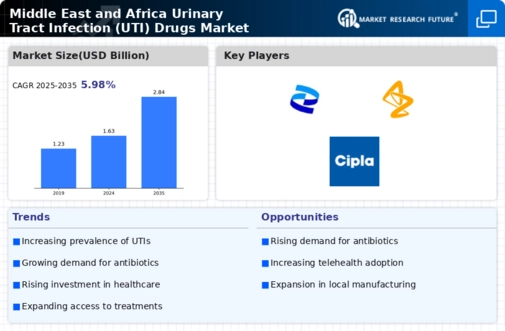Market Trends
Key Emerging Trends in the MEA UTI Drugs Market
There have been notable developments in the market trends of Urinary Tract Infection (UTI) drugs in the Middle East and Africa (MEA) region recently. The prevalence of this infection remains a significant concern to health stakeholders within the region thereby necessitating demand for effective pharmaceutical intervention. A striking example is growing awareness about and diagnoses of UTIs, which increase the demand for pain relief medicines ^that are meant to fix it^.
Governments and healthcare organizations in MEA are taking part in health promotion campaigns that stress the importance of early recognition and treatment of urinary tract infections. This has resulted into increase number of patients seeking medical interventions hence escalating demand for UTI drugs. Also, there is an increasing incidence rate among different age brackets including women and aged people, further expanding its scope.
However, pharmaceutical companies based in MEA are particularly focused on carrying out research activities aimed at introducing highly advanced and more efficient medication against UTIs. This gave birth to various innovative formulations as well as modes of drug administration thereby improving outcomes associated with therapy used. In addition to that, antibiotics resistance causing antibiotic resistance globally has received much attention from researchers such that drug manufacturers now concentrate on combination therapies as well as novel antibiotics with the aim of beating these challenges.
Furthermore, key players within this industry are participating more than ever before in collaborations and partnerships around MEA concerning UTI drugs together with other similar related issues. Consequently, it led them into coming up with remedies by pooling their knowledge base and making use of resources through teaming up with academic institutions and health research facilities. These new relationships try to address changes arising due to resistance patterns found among bacteria strains causing UTIs.
The governments within MEA should ease regulations associated with approving new vitamins so that they can be sold faster than before if not momentarily after being okayed by relevant authorities. Allowing this gives confidence among firms operating within these areas since they understand that regulatory paths have become more receptive to the introduction of new medications.
The market is experiencing a rise in uptake of telemedicine and digital healthcare platforms for UTI management. This trend has particularly found application in remote or underserved regions where access to traditional healthcare facilities may be limited. By incorporating technology into health services, patients not only have an easier way out for accessing consultations but also use digitized means to monitor and manage the disease such as UTIs.
But despite these developments, there are still challenges like fluctuations within economies and differing levels of infrastructure development across MEA countries. Affordability and availability of drugs used for treating urinary tract infections remain major challenges especially among poor nations. Governments together with other stakeholders in this industry are working on ways through which they can address these concerns thus ensuring that even the most advanced UTI treatments reach a larger population.














Leave a Comment